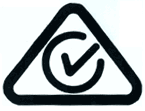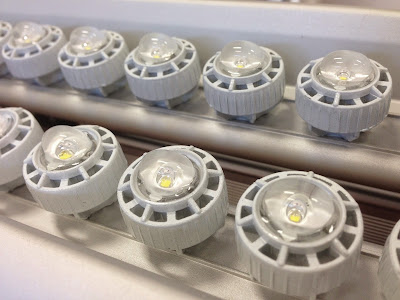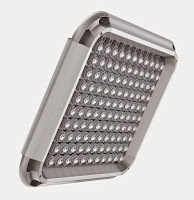This isn’t always the best bet for obvious reasons (and most obvious is that every application has its own particular challenges), but by asking your LED supplier some questions, risk can be minimized and providing the perfect solution for the client is more likely.
 The Regulatory Compliance Mark (RCM) (logo on left) indicates compliance to both electrical safety standards and Electromagnetic Compliance standards required for electrical equipment in Australia.
The Regulatory Compliance Mark (RCM) (logo on left) indicates compliance to both electrical safety standards and Electromagnetic Compliance standards required for electrical equipment in Australia.
Our Andromeda™ series has the RCM for Australia, cETL for Canada/US, CE and TUV for Europe.
IES files are a digital representation of the lamp/luminaire’s performance characteristics, and these files are used by lighting designers or electrical engineers to simulate the lighting for a given application (digital proof of concept). All reputable companies should be able to provide IES for their products.
We have IES files for most of our 9000 versions of Andromeda™ available on our website for easy download.

The brand of diode is worth knowing, as with everything there are premium brands (such as Nichia, CREE, Seoul Semi-Conductor, etc…) which are well established and may indicate a better product or at least quality of light.
But more important is the LM-80 report which is an approved method for measuring the lumen maintenance and chromaticity shift of LED light sources. In layman’s terms this test report provides information how about how long the LED engine in the luminaire should last, and how well the quality of light will be maintained.
Further, TM-21 calculations should be included in the report which can be used to predict the lifespan of the luminaires under varying conditions.
Our Andromeda™XPB uses Nichia 219B LEDs, for which a detailed LM80 report is available HERE. This diode is tested at three separate ambient temperatures (55⁰C, 80⁰C, 100⁰C) with values for lumen maintenance, chromaticity shift, and a TM-21 projection (L70(10K)) for each temp, which are all greater than 60,000 hrs.
If the luminaire in question is going to be used externally, or will be subjected to wet or adverse conditions it should have a relevant IP rating. You can look at a chart of IP ratings HERE. As a general rule luminaires used externally and subjected to the weather should have an IP rating of IP65 at least. Salt spray tests are also a necessity if the luminaires are placed in a corrosive environment (Category C- Category E) – from 50km from the Ocean. Further, specific tests should be conducted for environments with unique or especially challenging environments.
Our Andromeda™XPB series is rated IPI66, and has been salt spray tested to GB/T 10125 and GB/T 6461 for the pixel rail components. We also have conducted extra testing for our luminaires placed in highly corrosive environments, such as the high chlorine environments found in pulp and paper mills.
Lamp Circuit Power is the actual power usage of the entire luminaire. This includes the driver (transformer), LED engine, and any other electrical components attached to the unit. The LCP should be tested by a NATA certified laboratory, particularly if calculations based on the LCP are to be used to apply for power/carbon saving based incentives.
As part of our LM79 reports we’ve included testing for LCP. For instance, our 300W Andromeda™XPB LCP is only 283.3W. In the “off” position our 150W driver for our Andromeda™ consume 1.3W of power (an Andromeda™XPB 300W has two 150W drivers – therefore 2.6W of power).
Junction temperature (TJ) is the temperature measured at the semi-conductor (LED) itself during operation. Tj is typically measured at various ambient temperatures to ensure that the recommendations of the diode manufacturer are being met. Tj temperatures that meet, or are lower than the LED manufacture’s recommendation indicate excellent thermal management and will ensure that the diodes meet both their performance and lifespan characteristics. Tj temps which exceed stated limits typically mean poorer performing diodes and shorter lifespans (if not outright failure).
Our Andromeda™XPB series, driven at 600mA, has a Tj temp of 102⁰C at an ambient temp of 55⁰C. The Tj max for the Nichia 219B diode is 150⁰C. This indicates exceptional thermal management, guaranteeing performance and lifespan even at high ambient temperatures.

The quality or characteristics of light required for a given application vary widely. And without going too much into appropriate Colour Correlated Temperature (CCT) or Colour Rendering Index (CRI) it is useful to know what your application requires (practicality, or through and applicable standard) and ensure that your choice of LED mirrors or exceeds the requirement. The important question to ask here is “Does your choice in LED luminaire provide variability in both CCT and CRI to accommodate your requirements?”.
We offer a multitude of options in both CCT from amber (2300K) to very cool white (8500K )in a single diode, to 20,000K with colour mixing, and everything in between. We also offer high CRI options (95Ra+) for specific applications. Our CCT is binned within 175k for most of our luminaires. The most common Andromeda™XPB is ~4500K & CRI >75.
Power factor (PF) is expressed as a ratio of “real” vs. “apparent” power – with a perfect power factor being “1”. PF is important because it measures how effectively you are using power, and improving it can maximize current-carrying capacity, improve voltage to equipment, and reduce power losses – which leads to lower electricity bills.
The Andromeda™XPB series has a power factor of greater of >0.9, with typical luminaires in the series at 0.95 or greater. These are excellent values for lighting (for example, fluorescent technology often has PF values less than .80).
The DOE in the US limits lifespan claims at 50,000 hours, and Energy Star Standards require a 3 year warranty at least on LED lamps/luminaires. Most quality LED products should have at least a lifespan of 50,000 hours and a 3 year warranty.
By using the information in question 3 and 6 above, it can be shown that even in the most extreme conditions (ambient of 55⁰C) the Andromeda™XPB with Nichia 219 diodes will perform past 60,000 hours (to L70). As such we have a comprehensive warranty of 5 years on this product. It’s worth noting that at 12 hour per day, 365 day per operation, the luminaire would be expected to last for ~13 years.
This measurement has become a benchmark of LED performance. It is not necessarily always relevant, however, when replacing high intensity discharge luminaires it can indicate potentially large savings in power. The higher the efficacy, the greater the savings in power as compared to lower performing luminaires. It is important, however, to know the POST-OPTIC efficacy, not the luminous flux. As all that matters to an end-user is how much usable light is actually being emitted by the luminaire – versus how much is being generated (and lost) in the first place. This information is often available on the LM79 report.
Our Andromeda™XPB series has an efficacy of 115+lm/W post-optics which you can view HERE. This is very high compared to both traditional lighting and other LED products, and sets our luminaires apart as some of the most efficacious available.
 In my experience I’ve found that clients employing LED technology for brown field projects are more likely to take advice from their electrical contractor than employ an electrical engineer to assist in choosing the best technology. No fault of the contractor, but they are likely to go with what they know, or if they haven’t been exposed to LED technology on this level, what they’ve heard works well.
In my experience I’ve found that clients employing LED technology for brown field projects are more likely to take advice from their electrical contractor than employ an electrical engineer to assist in choosing the best technology. No fault of the contractor, but they are likely to go with what they know, or if they haven’t been exposed to LED technology on this level, what they’ve heard works well.
 The Regulatory Compliance Mark (RCM) (logo on left) indicates compliance to both electrical safety standards and Electromagnetic Compliance standards required for electrical equipment in Australia.
The Regulatory Compliance Mark (RCM) (logo on left) indicates compliance to both electrical safety standards and Electromagnetic Compliance standards required for electrical equipment in Australia.